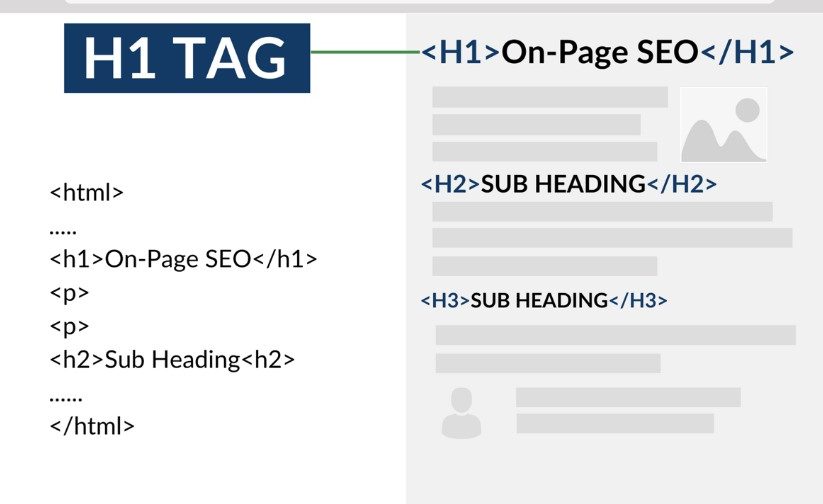Embarking on the digital pathway of online marketing or website development opens up a realm of terminologies and tools, among which H1 tags reign supreme when it comes to SEO optimization and web structure. The H1 tags SEO value is often underscored, but it plays a pivotal role in giving both search engines and your audience a clear indication of your content’s focus. Delving into what is an H1 tag and its significance can pave the way for a refined, SEO-friendly website.
Unveiling the H1 Tag
The H1 tag is the first-level heading of a web page, representing the primary title or headline. Unraveling the H1 meaning goes beyond just a mere title; it’s a clear indicator to search engines about the core subject of your page. This headline should encapsulate the essence of the content that follows, making it a crucial aspect of on-page SEO.
Now, what is an H1 tag in SEO? In the SEO realm, H1 tags are the bold declarations of a page’s intent, making it easier for search engines to index the page accurately. The more precise and keyword-rich your H1 tag is, the better your chances of ranking higher.
Although traditionally seen as just a headline, the H1 website tag’s influence extends to user experience. A captivating H1 tag can retain user attention, making them more likely to engage with the content that follows. It’s not merely a heading; it’s the entry point to your digital narrative.
The SEO Symphony of H1 Tags
The art of SEO is a meticulous one, where even the smallest elements like H1 tags can orchestrate a noticeable difference in your page ranking. The H1 tag definition according to SEO is the primary heading tag that search engines use to understand the essential topic of the page, making it a cornerstone for organic search ranking.
A common inquiry is, what does H1 mean in HTML? In HTML language, H1 is the tag used to define the most important heading on the page, with other heading tags (H2 to H6) serving lesser levels of importance. The hierarchy of these tags helps in structuring the content in a reader-friendly manner.
The beauty of H1 tags SEO lies in its ability to be both a technical SEO element and a creative component of web page design. Crafting an H1 tag that is both keyword-centric and captivating to readers is a subtle art that can significantly enhance the page’s SEO and user engagement.

The Business Behind H1 Tags
In the modern digital marketplace, understanding what H1 means in business is akin to unlocking a new level of SEO awareness. The H1 meaning extends beyond the realms of web development into the broader sphere of online business visibility and brand recognition.
What is an H1 header in the business scope? It’s the first impression your brand makes on both search engines and potential customers. A well-crafted H1 tag can set a compelling narrative for your brand, encouraging further interaction and engagement.
Moreover, the H1 website tag plays a crucial role in the consistency of brand messaging across various pages of a website. It’s not just a tag; it’s a powerful tool in the arsenal of digital branding and marketing, paving the way for better user experience and SEO rankings.
Exploring Further: H2 and Beyond
Venturing beyond the H1, the exploration into what is an H tag unveils a structured hierarchy that aids in organizing content logically and aesthetically. Each descending level, from H2 to H6, serves to structure content, making it easily navigable for readers and systematically indexed by search engines.
The H1 tag is the cornerstone, but incorporating H2, H3, and so on, enhances the overall SEO structure, making the content more accessible and logically organized. It’s a journey from the general to the specific, with each tag level delving deeper into the content’s sub-topics.
The seamless integration of H1 to H6 tags, while maintaining a coherent and keyword-optimized narrative, is a hallmark of well-structured, SEO-friendly web content. It’s a dance between technical SEO requisites and creative content presentation, culminating in a well-orchestrated user experience and optimized search engine performance.
Conclusion
In the burgeoning digital landscape, the H1 tags represent unsung heroes, orchestrating the SEO narrative of your webpage. They are the first touchpoint for both search engines and your audience, offering a glimpse into the content that follows. Understanding the H1 tag definition is akin to unlocking a foundational aspect of SEO, a step that paves the way for better visibility and ranking in the search engine realm. Moreover, an effective H1 tag acts as a magnet that can captivate the audience’s attention right from the outset, enhancing the user engagement and dwell time on your page.
Diving deeper into what is an H1 tag, one uncovers its multifaceted role not just in SEO, but also in enhancing user engagement and digital branding. It’s not merely about meeting the technical SEO requisites, but about crafting a compelling narrative that resonates with your audience. The H1 tag is where this narrative begins, setting the stage for the content that follows. With a well-crafted H1 tag, you’re not just optimizing for search engines, but enriching the user’s journey through your digital domain, laying down the red carpet for an engaging and enriching user experience.


